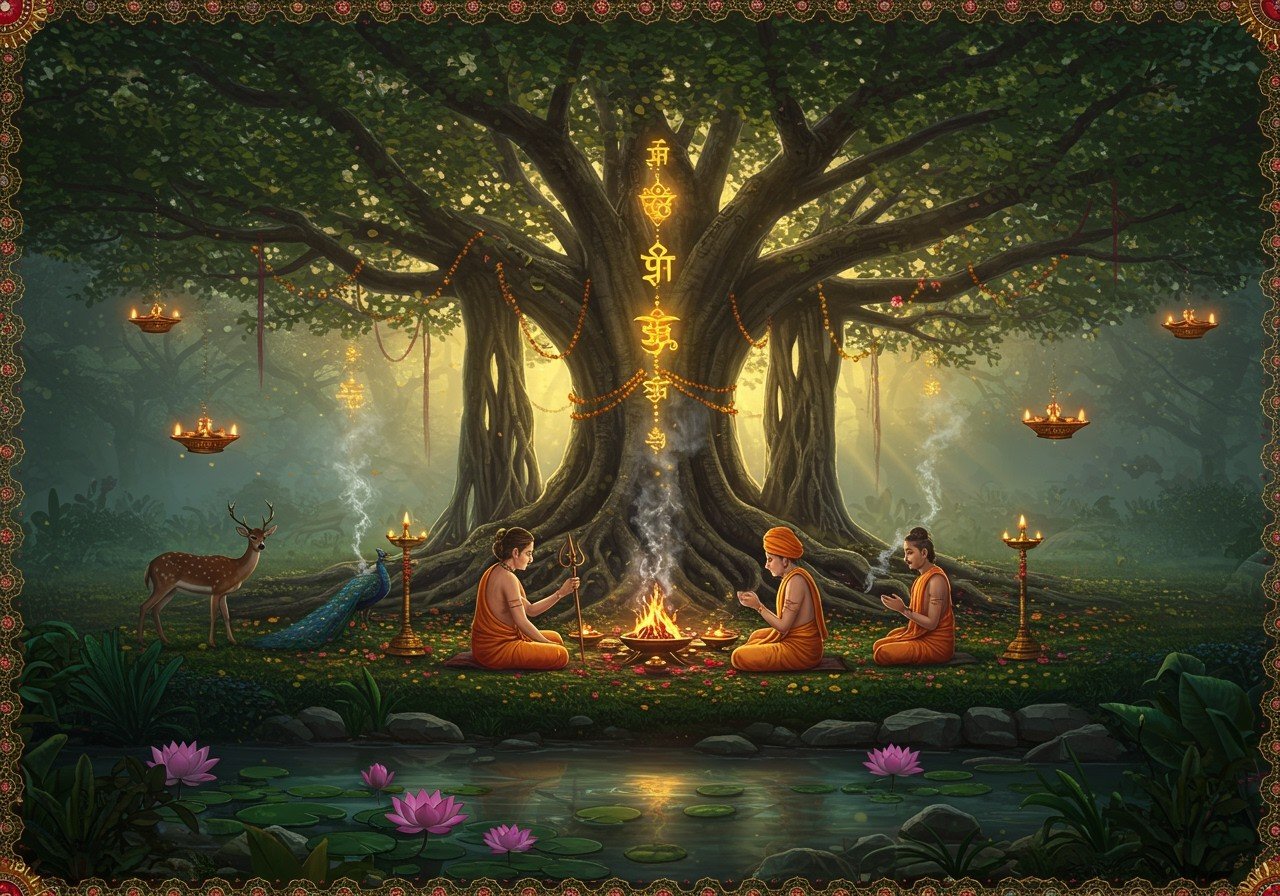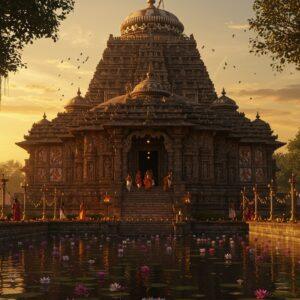
Embark on a journey to explore the intriguing world of nature worship theories, deeply rooted in ancient traditions and beliefs. Discover the significance of nature worship within paganism and its influence on modern spiritual practices. Appreciate the cultural richness of India, where nature worship has been practiced for millennia, and understand its relevance to contemporary society. Highlight the importance of preserving these traditions in an increasingly digital world, providing a convenient way for culturally rooted Indians to engage with their spiritual heritage. For those seeking to deepen their understanding of Sanskrit mantras and their spiritual significance, Poojn.in offers a comprehensive guide to this ancient language.
Understanding Nature Worship Theory
Nature worship theory suggests that natural elements and phenomena hold spiritual significance. In many cultures, like Hinduism, rivers, mountains, and forests are revered as sacred spaces, embodying divine presence. Nature worship connects humanity with the divine and the universe, fostering a sense of belonging and interconnectedness. Rituals and festivals, such as Chhath Puja and Ganga Dussehra, reflect these beliefs by celebrating the sun and rivers, demonstrating how these theories are woven into spiritual practices. These practices often involve offerings of flowers, fruits, and incense, symbolizing respect and gratitude towards nature’s gifts.
Influential Figures in Nature Worship Theory
Explore key figures who contributed to nature worship theory. Early anthropologists like Sir James Frazer studied the links between natural phenomena and religious practices, laying the groundwork for understanding the origins of nature worship. Contemporary scholars have integrated ecological perspectives, emphasizing the interconnectedness of all living things and the importance of environmental stewardship. These ideas have been embraced by modern spiritual movements, highlighting the unity of all life forms and promoting ecological awareness. This renewed interest in nature worship also reflects a growing concern for environmental sustainability.
Nature Worship and Pagan Traditions
Examine the close connection between nature worship and paganism, a spiritual path that honors nature’s cycles and rhythms. Pagan traditions, with their emphasis on reverence for the Earth and its natural forces, have seen a revival, especially in Western countries, influencing global spiritual practices. Pagans view nature as sacred, imbued with divine energy, and conduct rituals to honor natural deities. Comparing pagan nature worship with Indian traditions reveals universal themes of reverence for the earth and the interconnectedness of life. This reverence often manifests in rituals and ceremonies designed to honor and appease nature spirits.
Cultural Significance in Indian Traditions
In India, nature worship is deeply ingrained in religious and daily life, reflecting a profound connection between spirituality and the natural world. Elements like the tulsi plant and sacred groves are integrated into Hindu practices, symbolizing purity and divine presence. The worship of animals such as cows and snakes reflects this connection, highlighting the sanctity of all life forms. Nature also influences Indian art, literature, and dance, where it symbolizes spiritual truths and the cyclical nature of existence. These practices offer valuable insights into sustainable living and harmonious coexistence with nature. You can find a variety of sacred items for your puja needs, including tulsi malas and other ritual accessories, at Poojn.in.
Modern Relevance and Adaptation
Nature worship theories remain remarkably relevant amid contemporary environmental challenges, offering guidance and inspiration for sustainable living and ecological awareness. They encourage us to reconnect with the natural world and recognize our role in preserving its delicate balance. Technology and online platforms make nature worship accessible to urban dwellers, bridging the gap between modern life and ancient traditions. Young Indians show a growing interest in reconnecting with their cultural roots through nature-centric spiritual practices, seeking meaning and purpose in a rapidly changing world.
Nature Worship as a Core Element of Paganism
At the heart of paganism lies a deep reverence for nature. Pagans view the Earth and its natural cycles as sacred, recognizing the divine energy that flows through all living things. They honor nature’s beauty and power through worship and rituals, seeking to connect with the spiritual essence of the natural world. Deities and spirits often embody natural elements like trees, rivers, and mountains, personifying the forces of nature. This connection forms the essence of animism, the belief that every part of nature possesses a spiritual significance. Celebrating the seasons is central to pagan traditions. Festivals like solstices and equinoxes mark nature’s cycles and transitions. Each celebration connects with specific deities and reflects the unique energy of each season. Pagans cherish these moments as opportunities to honor the divine energy present in nature and align themselves with its rhythms.
Historical Paganism and Nature
Nature worship has deep roots in European paganism. Celts and Germanic tribes believed in gods and spirits residing within natural elements, imbuing the natural world with spiritual significance. For instance, Thor, associated with thunder, symbolized nature’s raw power. In Ancient Greece, deities like Poseidon and Demeter personified natural forces. They were revered as protectors of the sea and agriculture, highlighting the importance of these elements in ancient life. Native American traditions also honored nature as powerful spiritual beings. The Great Spirit represented the creator of life, emphasizing the interconnectedness of all living things and the sacredness of the natural world. These historical practices highlight the universal appeal of nature worship across cultures.
Modern Paganism and Nature
Today, modern paganism embraces a diverse range of nature-centered beliefs and practices. Traditions like Wicca and Druidry draw inspiration from ancient practices, adapting them to contemporary contexts. Wicca honors a goddess and god, emphasizing rituals that align with natural energies and promote personal growth. Druidry focuses on harmony with the Earth, drawing wisdom from ancient Celtic traditions and emphasizing ecological awareness. Ecology plays a vital role in contemporary paganism. Many pagans actively engage in environmental conservation efforts, recognizing their responsibility to protect the Earth. They seek to reconnect with nature, fostering a deeper understanding of ecological balance and the interconnectedness of all life. This focus on ecology aligns with modern values of sustainability and environmental responsibility. Find resources and products related to Wicca and Druidry, including books and ritual tools, at Poojn.in.
Nuances and Perspectives
Not all pagans worship nature in the same way. Some focus on deities representing specific aspects of nature, while others cultivate a direct relationship with nature through animism. The term “worship” itself can have diverse meanings and expressions. Many pagans honor nature as sacred but may differ in their approaches to rituals and practices. Scholars debate the extent of nature worship in ancient times. Some suggest that ancient people primarily revered deities governing human endeavors rather than personifications of nature itself. Despite these nuances, the enduring connection between paganism and nature remains a source of inspiration and spiritual growth for many today. Explore a wide selection of incense and dhoop, perfect for creating a sacred atmosphere during nature worship rituals, at Poojn.in.
How Poojn.in Supports Your Nature Worship Practices
Poojn.in offers a wide array of essential items for nature worship rituals in the Hindu tradition, ensuring authenticity and purity for your spiritual practices. We provide:
- Pure copper kalash for water worship: These kalash are crafted with care to maintain the sanctity of water rituals.
- Natural cotton wicks for agni puja: Our wicks are made from pure cotton, ideal for fire ceremonies.
- Organic kumkum and haldi for earth element rituals: Sourced from natural ingredients, these powders add a sacred touch to earth-based practices.
- Pure silver and brass diyas for light worship: Beautifully crafted diyas illuminate your sacred space and enhance your connection with the divine.
- Authentic panchamrit ingredients for abhishekam: Prepare traditional offerings with our high-quality panchamrit ingredients.
- Traditional incense and dhoop for air element worship: Create a purifying atmosphere with our selection of incense and dhoop.
- Tulsi plants and accessories for plant worship: Honor the sacred tulsi plant with our plants and accessories.
All items are carefully sourced and verified for purity according to Vedic standards, ensuring the authenticity and sanctity of your rituals. Our products come with detailed usage instructions in multiple languages, making them accessible to a wider audience. We offer convenient home delivery across India with secure packaging to maintain the sanctity of the items. Visit www.poojn.in or call our customer service for guidance on selecting the right items for your nature worship rituals. Our knowledgeable team can help you choose products based on specific regional customs and family traditions. Shop Nature Worship Items at Poojn.in
Embracing Nature’s Wisdom
Nature worship offers a timeless connection to the world around us, reminding us of the Earth’s inherent beauty and power. Whether through ancient rituals or modern practices, pagans find inspiration in nature’s cycles and rhythms. These beliefs encourage a respectful and harmonious relationship with our environment, fostering a sense of responsibility and stewardship. As we explore nature worship, we discover its universal appeal, bridging ancient traditions with modern values and emphasizing the importance of ecological awareness. By honoring nature, pagans celebrate the interconnectedness of life and the sacred energy that flows through all things. This journey invites us to appreciate the wisdom and wonder that nature provides, guiding us towards a more balanced and mindful existence.
FAQs on Nature Worship Theories: An Exploration
What is nature worship theory? Nature worship theory proposes that humans have always held reverence for natural elements like the sun, moon, rivers, and trees, viewing them as sacred or divine. This reverence stems from a recognition of nature’s power and its essential role in sustaining life.
Who is the main proponent of nature worship theory? Edward Burnett Tylor, a prominent anthropologist, is often considered a key figure in developing nature worship theory. His work explored how early humans likely formed religious beliefs centered around the natural world, attributing spiritual significance to natural phenomena.
How does nature worship differ from other religious practices? Nature worship distinguishes itself by focusing on the veneration of natural elements rather than deities or gods in anthropomorphic forms. It emphasizes a direct, experiential connection with the environment and is often observed in tribal and indigenous practices, where nature plays a central role in daily life and spiritual understanding. You can explore a range of products for your puja needs, including diyas and incense, at Poojn.in.
Why do people practice nature worship? People engage in nature worship to express gratitude for nature’s abundance, seek guidance from its wisdom, and maintain harmony with the environment. It reflects a deep-seated respect for the natural forces that sustain life and a recognition of humanity’s interconnectedness with the natural world. Discover a selection of puja items, including copper kalash and panchamrit ingredients, at Poojn.in.
Can nature worship be part of modern religions? Yes, elements of nature worship are interwoven into many modern religions, enriching their spiritual practices. For example, Hinduism reveres rivers like the Ganges, while Buddhism often incorporates natural imagery and teachings about impermanence and interconnectedness. These examples illustrate how nature worship can complement and enhance established religious frameworks.
What are some examples of nature worship in history? History offers numerous examples of nature worship across diverse cultures. Ancient Egyptians worshiped the sun god Ra, while Native American tribes conducted ceremonies to honor the earth and sky. These practices demonstrate the widespread recognition of nature’s power and its integration into spiritual beliefs. You can find a variety of items for your puja needs, including organic kumkum and haldi, at Poojn.in.
Is nature worship still relevant today? Nature worship maintains its relevance in the modern world as people continue to seek a spiritual connection with the earth. It aligns with contemporary environmental movements that emphasize sustainability, ecological respect, and the urgent need to protect our planet. This renewed interest in nature worship reflects a growing awareness of environmental issues and a desire to live in greater harmony with nature.
How has nature worship influenced modern environmental practices? Nature worship has significantly influenced modern environmental practices by fostering a sense of stewardship and responsibility towards the environment. It encourages sustainable living, conservation efforts, and a deeper understanding of the delicate balance within ecosystems. By instilling respect for nature, it motivates individuals and communities to actively participate in protecting the planet. Explore a variety of eco-friendly products for your puja needs at Poojn.in.


